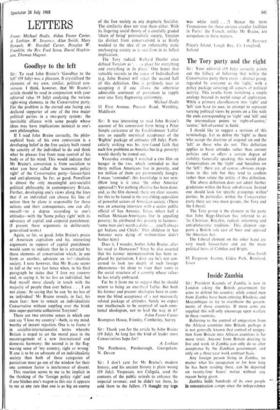The Tory party and the right
Sir : Your editorial (19 July) correctly points out the fallacy of believing that within the Conservative party there exists -t distinct group, regarded by everyone as the 'right,' with a policy package covering all aspects of political activity. This results from stretching a simple analogy beyond its useful range of application. While a primary classification into 'right' and 'left' can have its uses, to attempt to represent varying political views by points on a line with the ends corresponding to 'right' and 'left' and the intermediate points to 'right-of-centre,' 'centre,' left-of-centre' is futile.
I should like to suggest a revision of this terminology. Let us define the 'right' as those who accept the doctrine of original sin and the 'left' as those who do not. This definition applies to basic attitudes rather than current policies and so offers a certain degree of stability. Generally speaking, this would place Conservatives on the 'right' and Socialists on the 'left': there are, of course, obvious excep- tions to this rule but they tend to confirm rather than refute the utility of this definition.
The above definition does not admit further gradations within the basic sub-division. Instead one should look for specific groupings within' parties. In particular, within the Conservative party there are two main groups, the Tory and the Liberal.
The Tory group is the element in the party that John Biggs-Davison has referred to as 'its Christian, Royalist, radical, reforming and anti-plutocratic tradition.' This element sup- ports a British role east of Suez and opposed the Abortion Act.
The Liberal element on the other hand are very much laissez-faire and are the main political heirs of Cobden and Bright.
Alan Smith
83 Ferguson Avenue, Gidea Park, Romford, Essex






































 Previous page
Previous page